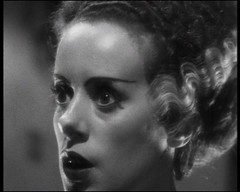 Image by Père Ubu via Flickr
Image by Père Ubu via Flickr
I say all this in spite of its glaring flaws as a sequel. It commits all the cardinal sins that a sequel should never do. It changes the tone of the original by introducing comedy, it retcons the ending of the original (if you have read or seen "Misery" this is an absolute no-no with die-hard fans) and unforgivably it brings in a new actress to play a leading role. If that weren't bad enough the titular character barely makes a cameo appearance. So what makes it so good?
The truth is 1935's The Bride of Frankenstein is James Whale's masterpiece. Despite exhibiting some of the first flashback sequences in a feature film during its opening prologue and some direct links via minor characters early on, the film stands alone as a great movie. Whale recognized how humour can be a valuable tool when dealing with horror. The comedy from the amazingly campish villaint Dr "It's my only weakness" Pretorious (played by Ernest Thesiger and apparently personally directed with relish by the openly gay Whale) , the black humour of Dwight Fray (once more playing a wicked assistant) and the hilarious hyserical moments on offer from the newly introduced Minnie the Frankenstein housekeeper (played by another Whale favourite, Una O'Connor) would have provided the relief required for the movie's darker aspects. This would be used again and again across the horror genre.
There is still the air of menace with Karloff putting in another great performance as the monster, but this time we get see more of his pathos - "We belong dead!"
Despite straying wildly off Mary Shelly's original novel, the film references much of its source material. It even begins with the trio who conceived the novel - Mary Shelly (the actual writer) and her two sources of influence and inspiration, Percy Shelly (her husband) and Lord Byron. Having been excited by Byron's insistance on recounting the events of the previouos film and the storm bellowing outside, Mary decides to tell them both what happened after the monster's apparent demise. Other references include a blind hermit (actually the blind elder member of the De Lacey family in the novel) and, of course, the plan to build a mate for the monster.
The Bride of Frankenstein stands out from all the other Universal classics for its sheer audacity (as well as the coded homeosexual element in Pretorious there are also plenty of references to Christ in the monster, despite having plenty taken out by the strict censors of its time), executed in true style.
If you enjoyed this review please show your appreciation by voting for it on the below link. It won't cost you a penny:
Ciao
Dooyoo
Don't forget to check out Jamie Clubb's main blog www.jamieclubb.blogspot.com
![Reblog this post [with Zemanta]](http://img.zemanta.com/reblog_e.png?x-id=883996ae-96ed-4a93-8a70-11dae61e7379)